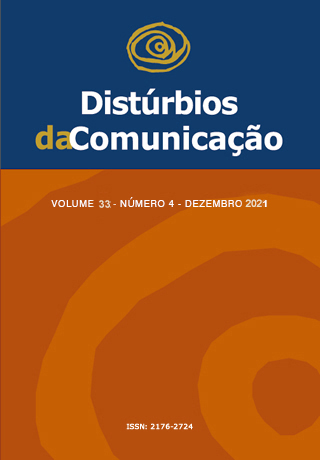Influence of orotracheal intubation on orofacial myofuncional changes in infants
DOI:
https://doi.org/10.23925/2176-2724.2021v33i4p705-711Keywords:
Intubation, Intratracheal, Infants, Facial Muscles, Speech, Language and Hearing SciencesAbstract
Introduction: Post-extubation swallowing changes are widely identified and studied, in which dysphagia is identified in the oral and pharyngeal phases, accompanied by laryngeal penetration and aspiration. However, orofacial myofunctional changes in post-extubation patients are still not well described in pediatrics. Objective: Verify the influence of orotracheal intubation on orofacial myofunctional changes in lactates. Methods: Cross-sectional study, performed in a Pediatric Intensive Care Unit from November 2015 to September 2016. Participants were divided into two groups: study group, with medical diagnosis of congenital heart disease, post-cardiac surgery, undergoing OTI for at least 6 hours, and the control group was composed of infants aged 0 to 6 months, previously healthy, who did not have any previous IOT. After selection, babies from both groups were submitted to the same assessment protocols. The clinical evaluation of the child’s orofacial myofunctional structures was performed using the Pediatric Dysphagia Assessment Protocol. Results: Lip posture, lip tone, tongue posture, palate, and vocal quality were significantly associated with the use of OIT, intraoral pressure and suction pattern. When analyzing the frequency distribution of the comparison with and without OIT, it is observed that there is no specific pattern that indicates whether the association is harmful, protective or does not interfere in the pattern of myofunctional characteristics in these cases. Conclusion: OIT influence was found in orofacial myofunctional structures in infants, when compared to babies who were not intubated.
Downloads
References
Matsumoto T, Carvalho WB. Intubação traqueal. J Pediatr (Rio J). 2007; 83(2 Suppl.): S83-90.
Wetmore RF. Tracheostomy. In: Bluestone CD, Stool SE, Alpes CM, Arjmand EM, Casselbrant ML, Dohar JE, et al., editors. Pediatric Otolaryngology. 4ª ed. Philadelphia: Saunders; 2003. p. 1583-98.
Fraga JC, Souza JCK, Kruel J. Traqueostomia na criança. J Pediatr (Rio J). 2009; 85(2): 97-103.
Allen DZ, Sethia R, Hamersley E, Elmaraghy CA, Chiang T. Laryngotracheal injuries after intubation in pediatric seizure patients: A case series and a review of the literature. Int J Pediatr Otorhinolaryngol. 2020;139: 110400.
Sassi FC, Medeiros GC, Zambon LS, Zilberstein B, Andrade CRF. Avaliação e classificação da disfagia pós-extubação em pacientes críticos. Rev Col Bras Cir. 2018; 45(3): e1687.
Almeida FCF, Bühler KEB, Limongi, SCO. Protocolo de Avaliação Clínica da Disfagia Pediátrica (PAD-PED). Barueri: Pró-fono; 2004.
Melo EM, Santos AMM, Silveira FMM, Sombra RLS, Alves RL, Lima VF. Clinical and demographic characteristics of patients on mechanical ventilation in the intensive care unit. Revista de Enfermagem da UFPI. 2015; 4(3): 36-41.
Paredes ER, Junior VN, Oliveira ACT. Protocolo de prevenção de falha de extubação como estratégia para evitar as complicações da reintubação precoce. Revista UNILUS Ensino e Pesquisa. 2013; 10(19): 12-9.
Jain MK, Patnaik S, Sahoo B, Mishra R, Behera JR. Tracheostomy in Pediatric Intensive Care Unit: Experience from Eastern India. Indian J. Pediat. 2021; 88(5): 445-9.
Principi T, Morrison GC, Matsui DM, Speechley KN, Seabrook JA, Singh RN, et al. Elective tracheostomy in mechanically ventilated children in Canada. Intensive Care Med. 2008; 34(8): 1498-502.
Watters KF. Tracheostomy in Infants and Children. Respir Care. 2017; 62(6): 799-825.
Cordeiro AMG, Fernandes JC, Troster EJ. Possible risk factors associated with moderate or severe airway injuries in children who underwent endotracheal intubation. Pediatr Crit Care Med. 2004; 5(4): 364-8.
Cordeiro AMG, Shin SH, Fernandes ICOF, Bousso A, Troster EJ. Incidence and endoscopic characteristics of airway injuries associated with endotracheal intubation in children. Rev Assoc Med Bras (1992). 2004; 50(1): 87-92.
Souza N, Carvalho WB. Complications of tracheal intubation in pediatrics. Rev Assoc Med Bras (1992). 2009; 55(6): 646-50.
Jang M, Basa K, Levi J. Risk fators for laryngeal trauma and granuloma formation in pediatric intubations. Int J Pediatr Otorhinolaryngol. 2018;107: 45-52.
Rutter M, Kuo I. Previsão e manejo do desenvolvimento da estenose subglótica após a intubação em crianças. J Pediatr (Rio J). 2020 ;96: 1-3.
Favero SR, Scheeren B, Barbosa L, Hoher JA, Cardoso MCDAF. Complicações Clínicas da disfagia em pacientes internados em uma UTI. Disturbios da Comunicação. 2017; 29(4): 654-62.
Tsai MH, Ku SC, Wang TG, Hsiao TY, Lee JJ, Chan DC, et al. Swallowing dysfunction following endotracheal intubation: Age matters. Medicine (Baltimore). 2016; 95(24): e3871.
Chen CC, Wu KH, Ku SC, Chan DC, Lee JJ, Wang TG, et al. Bedside screen for oral cavity structure, salivary flow, and vocal production over the 14days following endotracheal extubation. J Crit Care. 2018; 45: 1–6.
Su H, Hsiao TY, Ku SC, Wang TG, Lee JJ, Tzeng WC, et al. Tongue weakness and somatosensory disturbance following oral endotracheal extubation. Dysphagia. 2015; 30(2): 188–95.
Erenberg A, Nowak AJ. Palatal groove formation in neonates and infants with orotracheal tubes. Am J Dis Child. 1984;138(10): 974-5.
Downloads
Published
Issue
Section
License
Copyright (c) 2021 Vanessa Souza Gigoski de Miranda, Laura Battistin Schiavoni, Rafaela Soares Rech, Lisiane De Rosa Barbosa, Gilberto Bueno Fischer

This work is licensed under a Creative Commons Attribution 4.0 International License.









